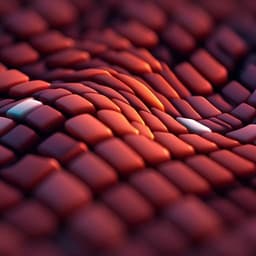
Engineering and Technology
Moderate-coherence sensing with optical cavities: ultra-high accuracy meets ultra-high measurement bandwidth and range
J. Dickmann, L. S. Neto, et al.
Discover a groundbreaking advancement in interferometric sensors by Johannes Dickmann, Liam Shelling Neto, Steffen Sauer, and Stefanie Kroker. This innovative approach leverages a cavity-based concept with a laser of moderate coherence, achieving unparalleled accuracy and an extended measurement range. Experience length sensing with an incredible precision of 1 nm over 120 µm, making cutting-edge technologies more accessible!
~3 min • Beginner • English
Introduction
Achieving simultaneous ultra-high accuracy and wide measurement range is a long-standing challenge in interferometric sensing because the periodic nature of interference fringes limits unambiguous range. Despite landmark precision in systems such as gravitational wave detectors and ultrastable lasers, limited measurement range and bandwidth constrain broader practical utility, especially for fast or transient events. This study proposes moderate-coherence sensing: using the limited coherence of a stabilized Fabry–Pérot laser and a low-finesse optical cavity, the method exploits both the sensitive interferometric phase signal and the visibility of fringes. The research question is whether visibility, which varies predictably with cavity length under moderate coherence, can be combined with mid-fringe detection to deliver nanometer accuracy across large ranges and high bandwidth. The goal is to experimentally validate this concept in length measurements and quantify accuracy, range, and speed.
Literature Review
The paper situates the work within interferometric metrology, highlighting state-of-the-art precision achievements (e.g., gravitational-wave detectors with strain sensitivity better than 10^−21 and ultrastable lasers around 10^−17), yet noting their limited dynamic range due to phase periodicity. Conventional range-extension uses active control (e.g., feedback-stabilized Michelson interferometers), which adds complexity and bandwidth constraints. Applications demanding both high accuracy and large range include precision manufacturing, biomedical sensing, and structural health monitoring. The concept draws on understanding of complex lasers with controllable coherence and Fabry–Pérot resonator theory. The authors’ approach leverages moderate laser coherence to encode absolute length information in visibility, reducing reliance on slow active stabilization.
Methodology
The methods comprise theoretical modeling, numerical analysis of laser parameter influence, laser characterization, and an experimental sensing setup:
- Theoretical description: A low-finesse Fabry–Pérot cavity formed by two wedged silicon wafers is probed at 1.55 µm (n(Si)=3.4757), yielding mirror intensity reflectivity R≈30.6% and Lorentzian finesse ≈2.65. The laser is a temperature-stabilized Fabry–Pérot diode emitting multiple quasi-monochromatic modes weighted by a Gaussian gain spectrum G(λ)=G0 exp(-(λ-λ_center)^2/Δλ_FPL^2), with λ_center=1.55 µm. For each mode i (wavelength λ_i), the single-pass roundtrip phase is φ_i(L)=2πL/λ_i. The transmitted intensity per mode is I_trans = [(1−R)^2]/[(1−R)^2 + 4R sin^2 φ_i] × G(λ_i), and the total reflected power is P_ref = 1 − Σ I_trans. From the fringe extrema, visibility V(L)=(I_max−I_min)/(I_max+I_min) is computed. Calculations show quasi-periodic fringes whose visibility decreases with cavity length, exhibiting an approximately linear regime from ~10 to 120 µm.
- Influence of laser parameters: Numerical simulations vary the gain width Δλ_FPL and line spacing Δλ_space to assess their effect on visibility. Wider gain (larger Δλ_FPL) reduces coherence and increases the visibility trend magnitude with length, enhancing the monotonicity useful for absolute ranging. When Δλ_space is small enough that many modes lie within the gain envelope (Δλ_space ≪ Δλ_FPL), visibility behavior is robust and nearly linear; excessively large Δλ_space (few modes) degrades linearity.
- Laser characterization: Using an optical spectrum analyzer, the gain envelope is fit to a Gaussian with width Δλ_FPL ≈ 3.82 ± 0.08 nm, and high-resolution scans yield a mode spacing Δλ_space ≈ 0.35 ± 0.02 nm, satisfying Δλ_space ≪ Δλ_FPL, supporting the moderate-coherence regime assumed.
- Optical sensing scheme: The laser (Thorlabs FPL1009S) is stabilized in temperature and current (CLD1015). Temperature stability of 0.01 K implies wavelength stability ~3 pm, contributing ≤0.23 nm measurement error over 120 µm. The output passes a Faraday isolator (IOT-H-1550A), fiber coupling, a beam splitter (TN1550R3A1) to provide a balanced detector reference (PDB450C), and a circulator (6015-3-APC) to free-space coupling (F280APC-1550) into the low-finesse cavity (wedged Si wafers WW80530). The second mirror is on a linear stage (NFL5DP20S/M) with manual travel (5 mm) and piezo range (20 µm), including a strain gauge (theoretical resolution 0.6 nm) for reference. Data acquisition uses NI USB-6363. The piezo travel alone is insufficient for the full 120 µm; manual offsets extend the range.
- Measurement procedure: For mapping 0–120 µm, manual offsets (0–100 µm) precede automated piezo scans over 0–20 µm in 2 mV steps (~0.6 nm), recording photodetector signals and computing visibility per Eq. (5). For real-time measurements, a ring piezo (PA44M3KW) rapidly scans over ~0.8 µm (~half-wavelength), at 20 kHz (resonance ~150 kHz with 0.9 g load, max displacement 3.9 µm). Each scan captures at least one fringe maximum and minimum. The algorithm computes: (1) visibility, giving an initial coarse length estimate (resolution ~0.3875 µm), and (2) mid-fringe extraction and linear regression to determine the mid-fringe offset relative to the scan, providing sub-nanometer refinement. A precomputed lookup table maps visibility to theoretical mid-fringe position L_vis. The final length is L_meas = L_vis − Offset.
Key Findings
- Demonstrated 1 nm accuracy over a 120 µm range using moderate-coherence sensing with a low-finesse cavity and a multi-mode FP laser.
- Bandwidth: real-time operation with 20 kHz scan frequency; overall measurement bandwidth from 0 Hz to 20 kHz. Single measurement time ~50 µs.
- Relative uncertainty: 0.00083% (i.e., 8.3×10^−6 relative) over 120 µm.
- Agreement between measured and theoretically calculated visibility across 0–120 µm with no visually detectable deviations, validating the model and the role of finite coherence.
- Real-time length determinations (examples):
• V=0.897 (negative mid-fringe): L_vis=26.988 µm, Offset=0.455 µm → L_meas=26.533 µm.
• V=0.657 (negative): L_vis=62.603 µm, Offset=0.317 µm → L_meas=62.286 µm.
• V=0.378 (positive): L_vis=103.266 µm, Offset=0.484 µm → L_meas=102.782 µm.
- Reproducibility (n=50 repeats): σ_MCS < ±0.3 nm at 26.533 µm and 62.286 µm; σ_MCS < ±0.6 nm at 102.782 µm.
- Speed constraint for 1 nm absolute accuracy: During the 50 µs measurement, length variation must be <1 nm, implying max target speed ~20 µm/s (higher with increased piezo frequency under suitable conditions).
- Laser stability contribution: 0.01 K temperature stability → ~3 pm wavelength fluctuation → ≤0.23 nm max length error over 120 µm.
- Laser spectral parameters: Δλ_FPL=3.82±0.08 nm; Δλ_space=0.35±0.02 nm, fulfilling Δλ_space ≪ Δλ_FPL for robust, near-linear visibility-length mapping.
Discussion
The findings address the central challenge of combining ultra-high accuracy with wide range and high bandwidth in interferometric sensing. By exploiting moderate laser coherence, the method encodes absolute length information in fringe visibility, while mid-fringe detection provides nanometer-level precision within each local scan. The strong agreement between measured and modeled visibility indicates that coherence modulation dominates the signal, allowing neglect of effects like minor misalignment or divergence under the tested conditions. Real-time implementation enables dynamic measurements at 20 kHz, making the technique suitable for applications requiring rapid, precise length tracking. Beyond length metrology, any measurand that modulates cavity length (temperature, acceleration, pressure, etc.) can be transduced with this approach, potentially enabling compact, high-performance sensors that avoid complex active stabilization while maintaining broad dynamic range.
Conclusion
This work introduces and experimentally validates moderate-coherence sensing with optical cavities, combining fringe visibility with mid-fringe detection to achieve sub-nanometer accuracy over a 120 µm range and up to 20 kHz bandwidth. The approach overcomes the traditional range limitation of interferometry without complex active stabilization, showing excellent agreement between theory and experiment. Future research could extend bandwidth and speed via higher-frequency actuators and optimized scanning, enhance robustness and range linearity through tailored laser spectra and cavity design, and adapt the method to other sensing modalities where cavity length transduces environmental parameters (e.g., temperature, pressure, acceleration).
Limitations
- Real-time 1 nm accuracy requires the measured length to vary by less than 1 nm during a ~50 µs scan, limiting allowable target speed to about 20 µm/s unless scan frequency is increased.
- At longer cavity lengths, reduced visibility yields smaller mid-fringe increments and increased noise, leading to larger standard deviations (up to ±0.6 nm observed at ~103 µm).
- The piezo-driven stage used has insufficient travel to span the full 120 µm without manual translation, complicating continuous-range automation in the prototype.
- Measurement accuracy depends critically on laser temperature stability; residual wavelength fluctuations (~3 pm for 0.01 K) contribute up to ~0.23 nm error over the full range.
- The method assumes a laser spectrum where Δλ_space ≪ Δλ_FPL; excessive mode spacing (few modes) reduces linearity and could degrade absolute ranging performance.
Related Publications
Explore these studies to deepen your understanding of the subject.







